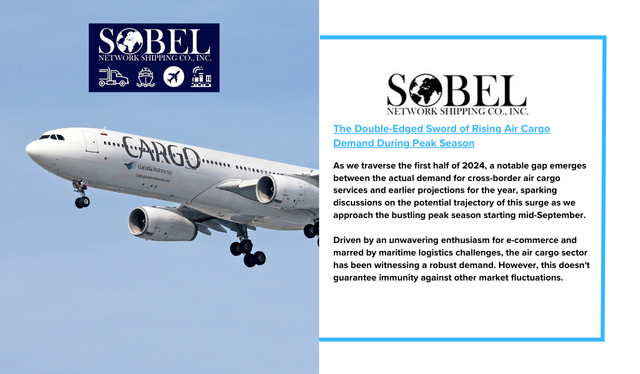As we traverse the first half of 2024, a notable gap emerges between the actual demand for cross-border air cargo services and earlier projections for the year, sparking discussions on the potential trajectory of this surge as we approach the bustling peak season starting mid-September.
Driven by an unwavering enthusiasm for e-commerce and marred by maritime logistics challenges, the air cargo sector has been witnessing a robust demand. However, this doesn’t guarantee immunity against other market fluctuations. Shippers, wary of potential delays from longer ocean transit times and complications such as the risky navigation around the Red Sea and possible dockworker strikes at U.S. East Coast ports this fall, are advancing their fall orders. This shift might be prematurely consuming the demand typically reserved for future periods rather than indicating a genuine uptick in trade activities.
The statistics might suggest a strong market, but they’re somewhat misleading. This year’s growth, though apparent, is calculated against a weaker first half of 2023 when cargo volumes fell by 10% from the previous year. As retailers had been conservative with their inventory orders, the market’s rebound in the latter part of last year sets a challenging precedent for maintaining similar growth rates moving forward.
Despite these nuances, the strain on capacity and consistent price hikes across main trade corridors are prompting businesses to secure transport deals for the impending peak season. According to Xeneta, a freight market tracker, airfreight volumes in June saw a 13% year-over-year increase, while shipping supply lagged behind with only a 3% rise. This marks the seventh consecutive month of significant growth in chargeable weight carried by airlines, indicating a strong recovery from an 18-month slump. Capacity utilization also saw a 4-point rise to 59%.
E-commerce, accounting for a fifth of the global air cargo volumes and even more along major export routes from Asia to Europe and North America, remains robust despite heightened scrutiny by U.S. Customs and Border Protection. Reports of e-commerce shipments from China facing minor delays have not significantly impacted air cargo traffic or led to canceled freighter flights.
The pressure on ocean shipping stems not from demand, which has only seen a slight increase, but from a thin supply line of vessels and containers. The skyrocketing costs of ocean freight, with rates significantly higher than during pre-pandemic times, are making air cargo a more viable option for many businesses. Rotate, an air cargo consultancy, notes that the gap between airfreight and ocean shipping costs is the narrowest since late 2022, making air cargo increasingly attractive.
Meanwhile, logistics providers are facing challenges in securing space with airlines for the remainder of the year, as Chinese e-commerce platforms have snapped up long-term capacity. The upcoming peak season may see a surge in rates, with potential increases up to 50% for those without prearranged space agreements.
As the second half of 2024 unfolds, the overall growth in air cargo demand is predicted to decelerate, primarily due to a strong performance in the last quarter of 2023, making high growth rates harder to sustain. With IATA forecasting a modest increase in airfreight traffic against a higher capacity growth, the industry might face reduced yields and a potentially softer market as the year ends.
Whether this surge in air cargo demand is a temporary boost or a sign of a longer-term shift in the transportation landscape remains to be seen. Nonetheless, businesses are adjusting their strategies, potentially reshaping the logistics industry for years to come.


